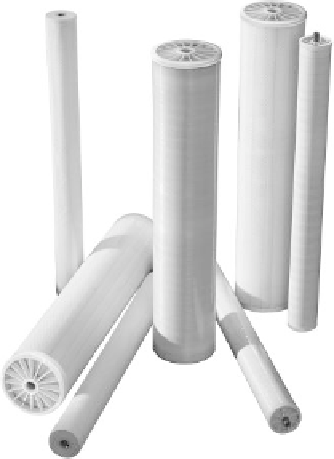Environmental Engineering Reference
In-Depth Information
39.3 Hyperfiltration
RO, also known as hyperiltration, represents the state of the art in water treatment tech-
nology. Developed in the late 1950s under US government funding as a method of desali-
nating sea water, today RO is one of the most convenient and thorough methods to ilter
water. It is used by most water bottling plants and by many industries that require ultra-
reined water in manufacturing.
During the RO process, water molecules are forced through a 0.0001-micron semi-
permeable membrane by water pressure. Long sheets of the membrane are ingeniously
sandwiched together and rolled up around a hollow central tube in a spiral fashion. This
rolled-up coniguration is commonly referred to as a spiral wound membrane or module.
They are available in different sizes for processing different quantities of water. Typically,
a module for home water treatment is as small as 2-in diameter and 10-in long, while one
for industrial use may be 4-in diameter and 40-in long (Figure 39.4).
For the membrane to be usable, it must be in some type of container (membrane housing)
so pressure can be maintained on its surface. It is this osmotic pressure that supplies the
energy to force the water through the membrane, separating it from unwanted substances.
Substances left behind are automatically diverted to a waste drain to prevent the build
up in the system that occurs with conventional iltering devices. This is accomplished by
using a part of the unprocessed water (feed water) to carry away the rejected substances
to the drain, thus keeping the membrane clean. This is the reason why RO membranes
can last so long and perform like new with minimum maintenance even after years of
operation.
FIGURE 39.4
GE offers multiple RO conigurations, including brackish, low-energy, low-fouling, high-temperature, seawater,
and wastewater membranes, which offer high salt rejection and energy-savings models.


